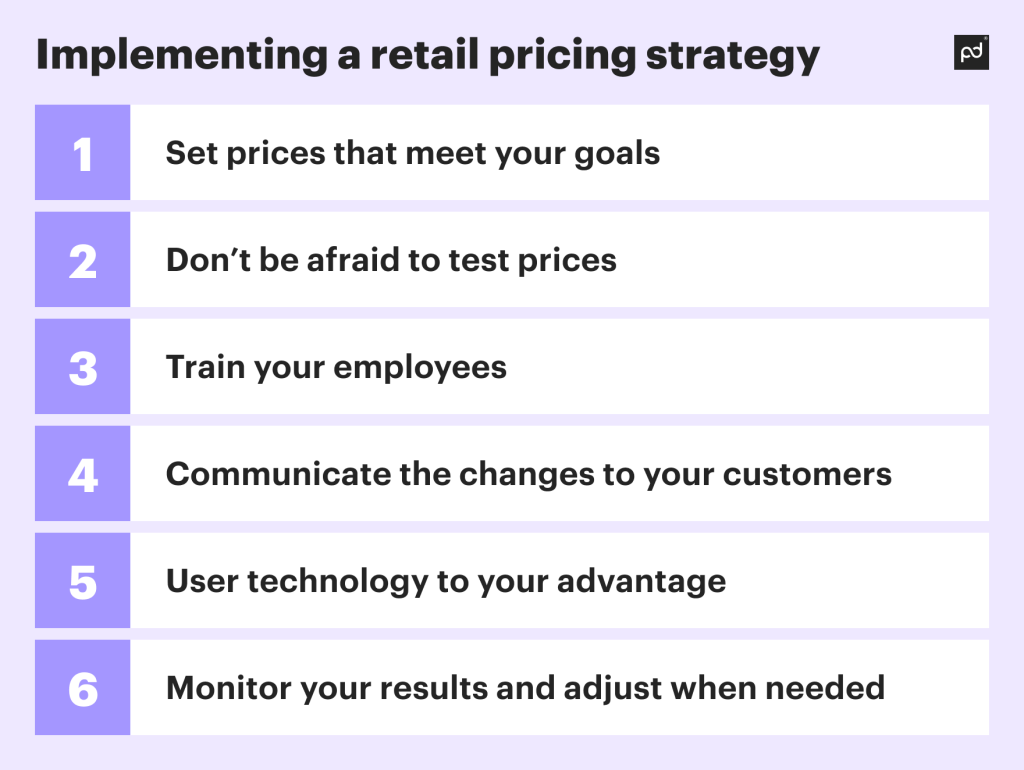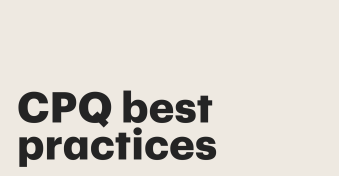What’s the first thing you look at when you’re torn between two comparable products?
Well, if you’re anything like me, it’s pricing. Also known as price skimming. Ok, not just me.
A 2022 survey reported that upwards of 80% of buyers1 assess competitor prices before deciding to purchase.
As a business, your pricing strategy needs to be competitive and adaptable to shifting markets.
Fortunately, CPQ (Configure, Price, Quote) is a tool that can process data and cut down on admin and guesswork to help you know your ideal price point.
Before we dig a little deeper into mastering your pricing strategy, let’s discuss what CPQ is and how it can help when it comes to setting prices.
What is CPQ?
Configure, Price, Quote software is a system that allows businesses to configure pricing products on a complex level, in addition to generating quotes.
Sales teams are able to easily peek at consumer data to adjust pricing as needed.
The automation features built into CPQ also significantly cut down on time spent in administrative tasks.
That way, stakeholders can focus on big picture items like pricing strategy and tactics.
HAAS Alert reported saving over 120 hours of admin work each month, which led to a 66.67% increase in efficiency by utilizing PandaDoc CPQ for HubSpot.
Bonus: We recently launched PandaDoc CPQ for HubSpot to help you improve the buying experience and streamline consistency with pricing.
Now you can create accurate quotes for complex products & services with ease. Learn more here.
Different pricing strategies

Pricing isn’t about blindly throwing a dart at a board and choosing whatever number you land on.
There’s a few common pricing strategies with intentional tactics behind them.
What best applies to your marketing strategy comes down to what you’re selling and your ideal customer.
Let’s go over some of the most common pricing models, along with their pros and cons.
What is the best pricing strategy for you?
Let’s go over some pricing strategy examples, as only you can decide on your pricing method of choice.
Cost-plus pricing
Cost-plus pricing model is as basic as it sounds. Take the cost of your product, and mark it up.
Pro: Easy, simple way to create pricing and margin profits.
Con: Not strategic. Doesn’t take into account competitor pricing or a customer’s willingness to pay (WTP).
This is particularly a disadvantage in the SaaS industry, where a value-based approach resonates best with targeted consumers when it comes to the bottom line.
Competitor-based pricing
Competitor-based pricing is, yep, you guessed it, pricing based on your competitors.
Whether it’s having a lower price to edge out the competition, or a higher price to convey perceived value, this competitive pricing strategy can be hit or miss.
Pro: Watching your competitors helps you stay within market range and adjust to changes as needed.
Con: If this is your sole focus, you risk losing sight of a value-based approach and may lose revenue and customers with too many fluctuations.
Value-based pricing
This one is a bit more ambiguous, but with the right data, it can be a highly effective approach.
Industries like SaaS are value-based, and need to position themselves as such to stand out from the crowd.
Also known as the premium pricing strategy.
Ahem speaking of, you are reading a PandaDoc blog, did you know we offer a free 14-day trial?
Pro: Most effective for maximizing revenue with the WTP approach.
Con: Diligent research and a constant ear to the ground are required to stay on top of things and remain in-tune with consumer reviews.
Penetration pricing strategy
This strategy is often utilized by those moving fast. It’s the tactic of setting a low initial price to attract customers and get their foot in the bigger market with the intent to gradually raise prices later.
Pro: Helpful when coming into a saturated market, as consumers will be more likely to give you a try if your price is exceptionally lower than the competition.
When done right, this can be a highly effective pricing strategy.
Con: With high reward comes higher risk.
You could be losing long-term revenue and customers as pricing increases. Especially if done too often, and too quickly.
Dynamic pricing strategy
Dynamic pricing uses real-time market trends and data from inventory levels and customer demand.
Pro: Flexible with a shifting market, giving businesses more leverage with profit margins.
Con: Too many price adjustments risks losing customers and having the business come off as lacking confidence in their value and positioning in the marketplace.
Tiered pricing
Tiered pricing offers products or services at multiple price levels, correpsonding to a set of features or usage limits.
A tiered pricing approach helps businesses cater to different customer segments by providing options that alighn with their needs and budget.
Pros: Enhances the buying experience by outlining the value of each tier and making it easy for customers to choose.
May also encourage customers to upgrade to higher tiers when their company or business needs expand, which can increase customer lifetime value.
Cons: Requires careful structuring to avoid too many choices or confusing about pricing theirs.
Bundle pricing
Bundle pricing involves combining complementary products or services and selling them as a bundle with a combined price. This is often a better deal than purchasing each item individually.
Software and service companies often use a bundle pricing strategy.
Pros:
- Increases sales volume: By offering multiple items at a reduced price, customers are more likely to purchase more.
- Introduces new products: Companies can bundle high-demand products with lesser-known products to introduce customers to new offerings.
- Simplifies purchase decisions: Customer receive a curated set of products that meet their needs.
Cons:
- Lower perceived value: Customers may think bundled items are of lesser quality.
- Decreased profit margins: Offering discounts on bundles can reduce profit margins, especially when high-value items are included at lower price points.
Inventory challenges: Managing bundled products can be difficult, especially when items are also sold separately.
Mastering your pricing strategy
Alright, as promised, now comes the meat and potatoes part of the blog.
You may be sitting here nodding, scrolling, ready to sink your teeth into how to utilize your (new) knowledge of CPQ and pricing models to your advantage.

Here’s what you need to ask yourself when crafting your perfect price:
Value & Market Position:
- While lower pricing may be effective initially, it can also be associated with a cheaper product. How do you plan to market your value to consumers? Also known as, value-based pricing.
Business Goals:
- Which matters more to you right now, market share or long-term value?
- Are you aiming to be cost-based, or going off the value of your product?
- Depending on your product, have you factored in the cost of production, and consumer demand?
Customer Perception:
- How do you plan to clearly communicate price fluctuations to your customers?
- What are the pain points customers currently have in your industry, and how can you best solve for their needs to promote customer value?
Competitors:
- Who are your biggest competitors? Look for 3-5, depending on your industry.
- What are their prices, and how do they vary?
- Are your services/products comparable, or do you have specifics they may not?
- Based on market research, do they offer freemium pricing or bundle pricing options, and will you?

On the flip side, it’s equally important to understand what makes a weak pricing strategy.
Poor targeting:
- Not marketing correctly, reaching the wrong customers and losing out on the right ones.
- A high price with too much markup for the customer base.
Incorrect value portrayal
- Exaggerating what the consumer will get with their purchase, pricing too low for a high-value product, etc.
Not finding the sweet spot:
- Prices too high or too low compared to similar products will cause potential buyers to hesitate.
- Sales volume and price-sensitivity aren’t factored into decision making.
Pricing analytics
Pricing analytics is a data-driven strategy for understanding how pricing impacts a business.
Companies can use data insights to adjust their pricing strategy. This approach looks at competitor pricing, market trends, and customer behavior.
Pricing analytics can enhance profitability and allow audience segmentation and customized pricing, catering to diverse customer needs and preferences. Implementing pricing analtyics can give companies a competitive edge and boost customer satisfaction.
Learn more about how pricing analytics can help your business.
Pricing intelligence
Online pricing intelligence is another data-driven approach to optimize your pricing strategy.
Pricing intelligence involves continuously monitoring and analyzing competitor pricing, customer behavior, and market trends to make agile pricing decisions while ensuring competitiveness and profitability.
Implementing pricing intelligence helps businesses to respond to market changes and align pricing with customer expectations.
See how pricing intelligence can transform your pricing strategy.
Pricing strategy case studies
If you’re overwhelmed by narrowing down the best selling price, we’ve got you.
Sometimes it helps to look at historical data of companies who have been there, done that, and reported back on the trial-and-error of pricing strategies for you.
Disney+ and penetration pricing
Back in 2019, Disney+ was far from the first big studio to launch a streaming platform.
In fact, many considered them late to the game.
While Disney is a major household name, Netflix and Hulu dominated the market.
Method
So, what did Disney do?
They adopted the penetration pricing model2 to break into market shares and get traction by starting out with a fiercely-competitive low price of only $6.99 a month.
This business model positioned them to be the option with economy pricing for new customers, while still having a high-quality product.
Outcome
This strategy worked well for Disney+, who steadily increased their prices after accumulating a large customer base of monthly subscribers.
Part of the effect was positioning their value with more original content, such as The Mandalorian, and making access to all Marvel (a Disney company) and Disney content exclusive to their platform.
Canva and value-based pricing
The go-to graphic design site for non-graphic designers has moved through a few iterations since coming onto the scene in 2012.
In 2019, Canva had a flat-rate pricing model for a monthly subscription of $12.95 in addition to keeping their free basic plan.
Now, there’s also Canva for Teams at $14.99 monthly for 5 seats.
Outcome
Canva took the slow and steady approach3, letting customers discover and try them out before ever asking for money.
As word spread and use increased, they launched their first monthly subscription plan, backed by the added-value of new and improved features.
If someone didn’t need that, they could simply keep their free version.
A few years later, they added a third-tier value package for companies for a very small amount more, making the incentive to purchase the package rather than 5 individual Pro accounts.
At present, Canva has over half a million team subscriptions. Some are from large corporations, such as Zoom and Marriott.
Near the end of 2023, their customer subscriptions surpassed $2 billion4.
In their case, the slow and steady value-based pricing model was highly successful.
CPQ and dynamic pricing
Enterprise companies in fields such as SaaS benefit from CPQ when deciding their pricing model.
CPQ’s ability to simplify complex products and integrate with CRM and ERP systems allows it to tailor solutions and provide accurate pricing for higher profitability.
CPQ and pricing tools
CPQ’s ability to provide data-driven pricing gives its users a competitive edge.
Sales processes are streamlined, time is saved, pricing configuration can be automated, and tailored. Need we say more?
According to a Forbes article, sales teams spend an estimated low of 35% of their time actually selling.
Speeding up the sales cycle is one of the key benefits of implementing CPQ software.
Depending on your needs, and if you already have a CRM in place, there are a few options when it comes to choosing a CPQ software that’s right for you.
We’ve done the research so you don’t have to.
By taking a look at the above blog you can see some of the highlights of the most commonly used CPQ software, and how PandaDoc stacks up against the competition.
PandaDoc CPQ is competitive in the landscape by streamlining your tools.
You can easily connect them so you don’t have to switch between programs, while ensuring all relevant teams have transparency and access for quick and easy alignment. And PandaDoc is the only CPQ solution with two-way CRM integration, meaning you can sync customer data between platforms to eliminate manual tasks and human error.
“CPQ has transformed our quoting process. Our quoting is not only more efficient but also much more attractive, offering an Amazon-esque experience to our customers. It has significantly streamlined our operations and enables reps to generate proposals in real time.”
Mike McCormick, Director of Employee Education
PandaDoc CPQ includes:
- CRM integrations for easy set-up
- Pricing rules
- Drag-and-drop editor
- Approval workflows
- Step-by-step selling
- Embedding trusted payment options to make closing easy
PandaDoc CPQ allows your team to easily manage all parts of the sales process.
Deciding on your pricing strategy is a crucial part of any business’s success.
Reaching your target audience and standing out to potential customers works when you have the right price for your product.
Said another way—your value proposition.
No matter what method you go with, remember that it’s a competitive market.
Market conditions fluctuate, and the right pricing strategy for you will with it. If it doesn’t work out, try another. Better, have CPQ do it for you.
Get a demo of PandaDoc CPQ and see how it can help your team interpret data and maximize revenue with pricing strategies.
- Statista, Share of global shoppers who usually compare prices before buying online as of August 2022 Show in the article ↑
- Marshall Johnston, Pricing Disney+ Show in the article ↑
- Top Lyne, 11 Examples of SaaS Pricing Done Right Show in the article ↑
- Famewall, Canva Usage, Revenue & Growth Statistics (in 2024) Show in the article ↑
Originally published November 8, 2024, updated March 11, 2025


